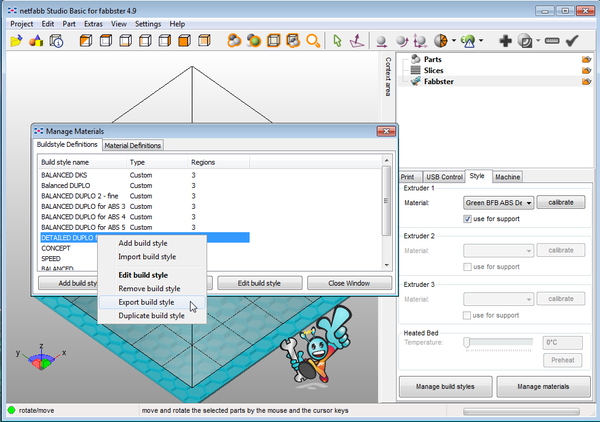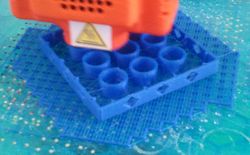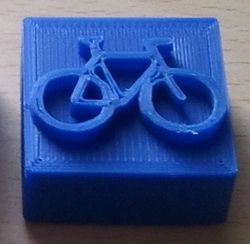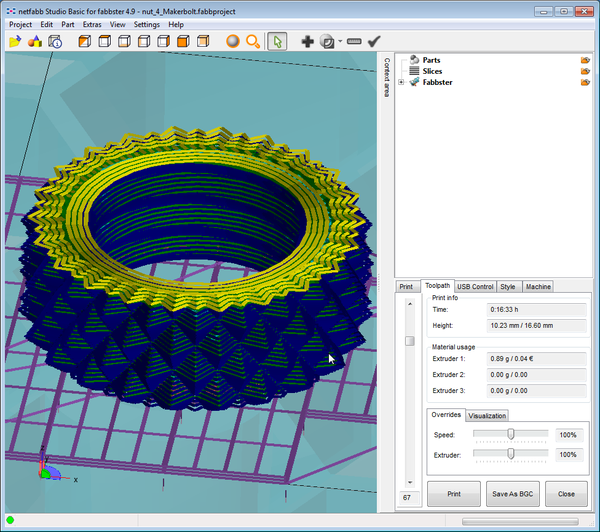Netfabb engine for fabbster build styles: Difference between revisions
mNo edit summary |
mNo edit summary |
||
| Line 6: | Line 6: | ||
* [[Netfabb engine for RepRap]] | * [[Netfabb engine for RepRap]] | ||
== Design principles and general tips == | |||
These styles, so far, were made for printing with plastic rolls. As you can see in the picture below - "Angelina" style behind and "Vanessa" style in front to the right, it's fairly easy to get decent enough prints using 0.25mm layers. | These styles, so far, were made for printing with plastic rolls. As you can see in the picture below - "Angelina" style behind and "Vanessa" style in front to the right, it's fairly easy to get decent enough prints using 0.25mm layers. | ||
| Line 28: | Line 28: | ||
* Make sure that the print head starts really close to the board. | * Make sure that the print head starts really close to the board. | ||
== Importing and exporting styles == | |||
You can import these settings to your Netfabb. To visualize if you are afraid, open with an XML editor or use [http://tecfa.unige.ch/guides/3dprinting/fabbster/config.html config.html] (an XSLT script that will show contents as ugly HTML). | You can import these settings to your Netfabb. To visualize if you are afraid, open with an XML editor or use [http://tecfa.unige.ch/guides/3dprinting/fabbster/config.html config.html] (an XSLT script that will show contents as ugly HTML). | ||
| Line 45: | Line 45: | ||
* '''You may have to adjust the temperature'''. I tend to use low temperatures (as compared to others in the fabbster community) and I even may try lower in the future. High temperatures are better for good flow, but increase warping and worsen overhang problems. | * '''You may have to adjust the temperature'''. I tend to use low temperatures (as compared to others in the fabbster community) and I even may try lower in the future. High temperatures are better for good flow, but increase warping and worsen overhang problems. | ||
== Reusable styles definitions == | |||
=== Angelina style === | |||
'''Purpose''': This style does mostly what is explained in this "calibration for dummies" section. It's not a very precise style, but it prints larger objects ok and fairly fast. | '''Purpose''': This style does mostly what is explained in this "calibration for dummies" section. It's not a very precise style, but it prints larger objects ok and fairly fast. | ||
| Line 68: | Line 68: | ||
[[image:netfabb-styles-2.jpg|thumb|600px|none|Angelina and Vanessa styles - Vanessa to the left, Angelina in the back]] | [[image:netfabb-styles-2.jpg|thumb|600px|none|Angelina and Vanessa styles - Vanessa to the left, Angelina in the back]] | ||
=== Vanessa style === | |||
'''Purpose''': This is another 0.25 style / material combination for "artistic" hollow objects. It is meant for printing out more slowly and it only has been tested with a small hollow object, i.e. the same pink panther woman on Duplo as above, only 8 times less volume. Think of Vanessa as ''Angelina, Lego sized''. It is not a precision style, but should produce acceptable quality. For higher precision styles, see Tinman (fine layers with medium speed), or R2D2 and Uma (0.25 layers at lower speeds) | '''Purpose''': This is another 0.25 style / material combination for "artistic" hollow objects. It is meant for printing out more slowly and it only has been tested with a small hollow object, i.e. the same pink panther woman on Duplo as above, only 8 times less volume. Think of Vanessa as ''Angelina, Lego sized''. It is not a precision style, but should produce acceptable quality. For higher precision styles, see Tinman (fine layers with medium speed), or R2D2 and Uma (0.25 layers at lower speeds) | ||
| Line 89: | Line 89: | ||
[[image:r2d2.jpg|thumb|250px|right|R2D2 style]] | [[image:r2d2.jpg|thumb|250px|right|R2D2 style]] | ||
=== R2D2 style === | |||
'''Purpose''': It is meant for printing out fine details slowly. This 0.25 style / material combination is meant for small "technical parts" like a hose retention clip posted by Gizmo in the Fabbster forum. However, it will not print at very detailed resolution since this simply can't be done with plastic rolls using the current extruder. | '''Purpose''': It is meant for printing out fine details slowly. This 0.25 style / material combination is meant for small "technical parts" like a hose retention clip posted by Gizmo in the Fabbster forum. However, it will not print at very detailed resolution since this simply can't be done with plastic rolls using the current extruder. | ||
| Line 113: | Line 113: | ||
[[image:netfabb-calibration-47.png|thumb|250px|right|Print two next to each for cooling down]] | [[image:netfabb-calibration-47.png|thumb|250px|right|Print two next to each for cooling down]] | ||
=== Hal style === | |||
'''Purpose''': It is meant for printing out small delicate objects as slowly as possible. This 0.25 layers style / material combination has been tested with a small Lego piece and a hand on top. However, it will not print these at very detailed resolution since this simply can't be done with plastic rolls using the current extruder. | '''Purpose''': It is meant for printing out small delicate objects as slowly as possible. This 0.25 layers style / material combination has been tested with a small Lego piece and a hand on top. However, it will not print these at very detailed resolution since this simply can't be done with plastic rolls using the current extruder. | ||
| Line 135: | Line 135: | ||
[[image:velo.jpg|thumb|250px|right|DUPLO with bike - Uma style]] | [[image:velo.jpg|thumb|250px|right|DUPLO with bike - Uma style]] | ||
=== Uma === | |||
Uma is a fairly solid and somewhat detailed 0.25mm layers style. Meant to be used for objects like duplos and figures that sit on top. However, very fine parts may not render well since the style is quite "fat". As all the others, it may need some further testing and tweaking | Uma is a fairly solid and somewhat detailed 0.25mm layers style. Meant to be used for objects like duplos and figures that sit on top. However, very fine parts may not render well since the style is quite "fat". As all the others, it may need some further testing and tweaking | ||
| Line 162: | Line 162: | ||
[[image:nut-and-bolt.jpg|thumb|250px|right|[http://www.thingiverse.com/thing:9095 Nut and Bolt (Thingiverse)] - Tinman style]] | [[image:nut-and-bolt.jpg|thumb|250px|right|[http://www.thingiverse.com/thing:9095 Nut and Bolt (Thingiverse)] - Tinman style]] | ||
=== Tinman === | |||
This is a 0.150mm style. It is meant for printing small solid objects (nuts and bolts). It is used with a standard netfabb Material style that is just modified for the raft. Print time for (fully filled) bolt using a standard pillar raft was about 9 minutes. This style is unsuitable for small tree-like structures (Eiffel tower, jewelry hand etc.) since it goes too fast. With plastic rolls you can't have both thin layers ''and'' snake speed. | This is a 0.150mm style. It is meant for printing small solid objects (nuts and bolts). It is used with a standard netfabb Material style that is just modified for the raft. Print time for (fully filled) bolt using a standard pillar raft was about 9 minutes. This style is unsuitable for small tree-like structures (Eiffel tower, jewelry hand etc.) since it goes too fast. With plastic rolls you can't have both thin layers ''and'' snake speed. | ||
| Line 192: | Line 192: | ||
The purpose of this section is not to provide any sort of serious comparison/benchmarking, but rather provide a feeling of what could be different and sometimes why.... | The purpose of this section is not to provide any sort of serious comparison/benchmarking, but rather provide a feeling of what could be different and sometimes why.... | ||
=== Vanessa vs. RD2D === | |||
Vanessa only works with artistic hollow objects and Duplos. For example, a Netfabb piece, i.e. a hose retention clip designed by Gizmo, cannot be printed with Vanessa. Legos don't come out nicely either, except for the walls, since these are simple to print. | Vanessa only works with artistic hollow objects and Duplos. For example, a Netfabb piece, i.e. a hose retention clip designed by Gizmo, cannot be printed with Vanessa. Legos don't come out nicely either, except for the walls, since these are simple to print. | ||
| Line 211: | Line 211: | ||
[[image:Netfabb-calibration-33.png|thumb|300px|none|Lego bottom with R2D2]] | [[image:Netfabb-calibration-33.png|thumb|300px|none|Lego bottom with R2D2]] | ||
=== R2D2 vs. Relaxed === | |||
"[http://wiki.fabbster.com/Predefined Relaxed]" is an official build style that is fairly complex and that could print large objects and details. It also will create stiff walls, since it will use half-layers (that is 0.075mm z-spacing). That means a lot of squeeze. Without testing, we can hypothesize that this should produce stiffer walls, but maybe less pretty ones. Interestingly, despite long print time, the relaxed style does compromise with inner elements. You can see that it uses less, i.e. prints with wider filament. | "[http://wiki.fabbster.com/Predefined Relaxed]" is an official build style that is fairly complex and that could print large objects and details. It also will create stiff walls, since it will use half-layers (that is 0.075mm z-spacing). That means a lot of squeeze. Without testing, we can hypothesize that this should produce stiffer walls, but maybe less pretty ones. Interestingly, despite long print time, the relaxed style does compromise with inner elements. You can see that it uses less, i.e. prints with wider filament. | ||
| Line 221: | Line 221: | ||
Since R2D2 uses much fatter layers, it will print faster than Relaxed. However, an "artistic" object should look as good. You will see the layers, but these should appear neatly. | Since R2D2 uses much fatter layers, it will print faster than Relaxed. However, an "artistic" object should look as good. You will see the layers, but these should appear neatly. | ||
=== Vanessa vs. R2D2 vs. Relaxed === | |||
The small Lego sized woman for which the Vanessa style fits well (except for the very small parts for now) also could be printed with the R2D2 and the Relaxed styles. Using little filling (around 5mm), the estimated print time for Relaxed is 2h22 as opposed to 40 minutes for the Vanessa style. With a solid fill, Relaxed would take about 3h20m. | The small Lego sized woman for which the Vanessa style fits well (except for the very small parts for now) also could be printed with the R2D2 and the Relaxed styles. Using little filling (around 5mm), the estimated print time for Relaxed is 2h22 as opposed to 40 minutes for the Vanessa style. With a solid fill, Relaxed would take about 3h20m. | ||
| Line 233: | Line 233: | ||
[[image:netfabb-calibration-30.png|thumb|600px|none|A less technical object (leg) - R2D2 Build style. Less fat, four walls, also more details for the very small parts]] | [[image:netfabb-calibration-30.png|thumb|600px|none|A less technical object (leg) - R2D2 Build style. Less fat, four walls, also more details for the very small parts]] | ||
=== R2D2 vs. Tinman === | |||
Tinman prints faster with smaller (0.15mm) layers and R2D2 prints slower with larger (0.25) layers. It also has more walls. For that kind of objects, Tinman provides better results, since the outside and the winding inside is trickier to print. | Tinman prints faster with smaller (0.15mm) layers and R2D2 prints slower with larger (0.25) layers. It also has more walls. For that kind of objects, Tinman provides better results, since the outside and the winding inside is trickier to print. | ||
| Line 241: | Line 241: | ||
[[image:netfab-calibration-39.png|thumb|600px|none|Nut - RD2D style]] | [[image:netfab-calibration-39.png|thumb|600px|none|Nut - RD2D style]] | ||
== Outlook == | |||
I should take the design idea from the official relaxed style and create a fast 0.25mm layer style that combines all of Angelina, Vanessa, R2D2 and more. | I should take the design idea from the official relaxed style and create a fast 0.25mm layer style that combines all of Angelina, Vanessa, R2D2 and more. Uma is simple attempt into this direction. | ||
.. | I also may go down to 0.2mm and then also play with double layers (0.4mm) for easier sections. | ||
[[Category: Fabbster 3D printer]] | [[Category: Fabbster 3D printer]] | ||
[[Category: 3D printing]] | [[Category: 3D printing]] | ||
Revision as of 19:57, 31 May 2012
Introduction
This article presents and discusses some simple build styles for the fabbster 3D printer and that can be imported into the Netfabb engine for RepRap
Read also:
Design principles and general tips
These styles, so far, were made for printing with plastic rolls. As you can see in the picture below - "Angelina" style behind and "Vanessa" style in front to the right, it's fairly easy to get decent enough prints using 0.25mm layers.
However, it may take about five attempts to get it right as the series of the small models in the picture shows (first attempt to the left left, first decent version to right). Creating a more universal style would take more time since you would have to test it with different objects and also make sure that it works with different sizes ...
Important general tips:
(1) We set a lower limit of 10 RPM printing (unless otherwise specified). This makes printing with these styles fairly safe. If you change the styles keep this principle unless you know what you do.
(2) Each build style has an associated material style. Typically, we use 0.25mm layers as opposed to 0.15 layers. Using our build styles with default fabbster material styles simply will not work !
(3) Make sure to get the temperatures right. I typically use between 255 and 270 degrees.
- higher temperature = easier (plastic comes out). But never go above 290 or you might produce glass instead...
- lower temperatures = better quality
If no plastic comes out with my settings:
- Raise the temperature a bit (by 5 degees)
- Make sure that the print head starts really close to the board.
Importing and exporting styles
You can import these settings to your Netfabb. To visualize if you are afraid, open with an XML editor or use config.html (an XSLT script that will show contents as ugly HTML).
To make our styles work you need to import both a build style and a material style ! These work together. In the Material style you would for example define layer size and definitions of speed and width. In the Build style you define how to use these definitions within different regions.
In Netfabb:
- Open Manage Materials, and right-click->Import. Choose a "reprapcalibration file" !
- Open Manage Build Styles, and right-click->Import. Choose a "reprapbuilstyle file" !
See the screenshots below:
You will have to select a filling:
- I suggest a minimum filling unless you print objects that must be strong. Move the slider rather to the right for less fill. All to the right is OK for larger objects that are not meant to be extremely solid.
- You may have to adjust the temperature. I tend to use low temperatures (as compared to others in the fabbster community) and I even may try lower in the future. High temperatures are better for good flow, but increase warping and worsen overhang problems.
Reusable styles definitions
Angelina style
Purpose: This style does mostly what is explained in this "calibration for dummies" section. It's not a very precise style, but it prints larger objects ok and fairly fast.
Get the latest combination from
E.g. as of May 18, these are:
- angelina-5.reprapcalibration (Material)
- angelina-5.reprapbuildstyle (Build Style)
Main features
- 0.25 layers
- medium/slow and medium/fast combinations
- Walls are 4 think (outer, inner1, inner2 and inner3
ToDo:
- Improve the small regions. Right now, small regions don't work well. The extruder goes too fast and uses too much width or both. The Vanessa style works ok with small regions and we should combine the two, i.e. copy/paste the small regions settings for starters.
Vanessa style
Purpose: This is another 0.25 style / material combination for "artistic" hollow objects. It is meant for printing out more slowly and it only has been tested with a small hollow object, i.e. the same pink panther woman on Duplo as above, only 8 times less volume. Think of Vanessa as Angelina, Lego sized. It is not a precision style, but should produce acceptable quality. For higher precision styles, see Tinman (fine layers with medium speed), or R2D2 and Uma (0.25 layers at lower speeds)
Style settings:
- Most width are fine
- Walls only have an outer and inner definition (two instead of four as in the Angelina style)
Material settings:
- It goes down to "snake" speed, however, snake means 25 mm/s in our associated Material style definition.
- No up and down jumping of the print head during jumps ! In other words the print head will move in a more quiet way. However, this means that some objects may not be printable. Print head could rip off the model if something sticks out.
- Minimal RPM is around 10. I.e. everyone should be able to use this style with plastic rolls.
Directory with build and material style:
Todo/Problems:
- Upper skins with a slight angle have holes (the upper side of her chest). Needs an extra region definition, but I have to figure out how to do this. One should (but can't) define a new small area that only would work if there is an angle from 5 to 30 degrees.
- The small region prints are too fast. I should take the settings from R2D2 in the same way as Angelina would need the small region settings of Vanessa. See the Uma style for better quality.
R2D2 style
Purpose: It is meant for printing out fine details slowly. This 0.25 style / material combination is meant for small "technical parts" like a hose retention clip posted by Gizmo in the Fabbster forum. However, it will not print at very detailed resolution since this simply can't be done with plastic rolls using the current extruder.
Style settings:
- Practically all width are fine and speed is mostly "snake" (25mm/s)
- Walls have 4 parts (or less if the wall is smaller)
- No up and down jumping of the print head during jumps ! In other words the print head will move in a more quiet way. However, this means that some objects may not be printable. Print head could rip off the model if something sticks out.
- Minimal RPM is around 10. I.e. everyone should be able to use this style with plastic rolls.
Directory with build and material style:
Important settings:
- Set Fill spacing to none: Slider in the Print panel to full left.
- If you print very hot, then you may get "noise" and the print head may rip off the whole thing. In the Material expert setting, set Z Offset in the Jump tab to something like 0.5mm. You also can lower RPM a tiny bit.
Todo/Problems:
- Better testing with other small technical parts
- Reduce flat areas a bit. That may be difficult, since I do want to stick to a minimum of 10 RPM right now. But a slightly "thinner" Material style should work.
Hal style
Purpose: It is meant for printing out small delicate objects as slowly as possible. This 0.25 layers style / material combination has been tested with a small Lego piece and a hand on top. However, it will not print these at very detailed resolution since this simply can't be done with plastic rolls using the current extruder.
Style settings:
- All parts are fine and speed is always "snake" (20mm/s), 9 RPM
- Walls have 2 parts (or less if the wall is smaller)
- Print head does up and down during jumps. Else it might rip off something
- No anti-stringing. This means that the printed piece will need some post-processing (cut/burn away strings)
Directory with build and material style:
Important settings:
- You may have to print double objects next to each other. Otherwise, the plastic will be too hot. In that case you must find a good temperature. I print 5 degrees higher than usual. This is bad for quality, but good for plastic coming out.
Todo/Problems:
- Try a version for sticks at some point ....
Uma
Uma is a fairly solid and somewhat detailed 0.25mm layers style. Meant to be used for objects like duplos and figures that sit on top. However, very fine parts may not render well since the style is quite "fat". As all the others, it may need some further testing and tweaking
Build style
- 4 Walls
- High overlap with filling (meaning that it can print flat roofs)
- 4 upskin and downskin layers (creates solid roofs)
- A special first 2 layers definition (a bit fatter)
- 3 regions that are all fairly detailed
Material style
- 0.250mm layers
- Raft: Lower speed, distance Grid/Part a bit lower (0.2)
- No Z Offset with Jumps
- Slightly lower anti-stringing
Settings
- For DUPLOS with hollow objects on top, I'd use a rather low filling (after all she got 4 walls)
- Temperatures should be as low as possible, i.e. plastic must come out nicely. Since ABS properties change, you may have to adapt a bit. E.g. Go higher for fabbster ABS. Test flow by setting RPM to 10.
Directory with build and material style:
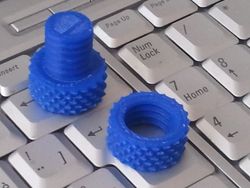
Tinman
This is a 0.150mm style. It is meant for printing small solid objects (nuts and bolts). It is used with a standard netfabb Material style that is just modified for the raft. Print time for (fully filled) bolt using a standard pillar raft was about 9 minutes. This style is unsuitable for small tree-like structures (Eiffel tower, jewelry hand etc.) since it goes too fast. With plastic rolls you can't have both thin layers and snake speed.
Build style
- 2 Walls
- Only one region
- Most elements are printed thin/medium
- Hatching (as always) for upskins and downskins
Material style
- 0.150 layers size
- Default fabbster settings, except for a few things
- Raft was set to be printed a bit slower.
Variants
- Tinman-1: 2 walls
- Tinman-2: 3 walls (better for larger objects with loose fills)
Settings
- You can set fill space to none (depends on the object)
- Adjust temperature to your plastic (I use 265-270)
Directory with build and material style:
Some styles compared
The purpose of this section is not to provide any sort of serious comparison/benchmarking, but rather provide a feeling of what could be different and sometimes why....
Vanessa vs. RD2D
Vanessa only works with artistic hollow objects and Duplos. For example, a Netfabb piece, i.e. a hose retention clip designed by Gizmo, cannot be printed with Vanessa. Legos don't come out nicely either, except for the walls, since these are simple to print.
R2D prints in much more detail and can print technical pieces. It will take at least 50% more time to print. You can see such differences in the capabilities of a style by examining the layers to be be printed in the Toolpath tab. If you see interrupted paths, walls that are too thin, etc. you must switch style. BTW the official "relaxed" Fabbster style could print this too I believe (not tested)
For other objects, the difference is less important. R2D2 prints at lesser speed than Vanessa and may lead to better results with Legos (no yet tested).
R2D2 vs. Relaxed
"Relaxed" is an official build style that is fairly complex and that could print large objects and details. It also will create stiff walls, since it will use half-layers (that is 0.075mm z-spacing). That means a lot of squeeze. Without testing, we can hypothesize that this should produce stiffer walls, but maybe less pretty ones. Interestingly, despite long print time, the relaxed style does compromise with inner elements. You can see that it uses less, i.e. prints with wider filament.
Since R2D2 uses much fatter layers, it will print faster than Relaxed. However, an "artistic" object should look as good. You will see the layers, but these should appear neatly.
Vanessa vs. R2D2 vs. Relaxed
The small Lego sized woman for which the Vanessa style fits well (except for the very small parts for now) also could be printed with the R2D2 and the Relaxed styles. Using little filling (around 5mm), the estimated print time for Relaxed is 2h22 as opposed to 40 minutes for the Vanessa style. With a solid fill, Relaxed would take about 3h20m.
Relaxed creates over 1000 layers and the contours are built with 5 walls. Vanessa uses about 600 layers and contours are built with 2 walls. R2D2 is like Vanessa, but more precise and it will take some extra time.
R2D2 vs. Tinman
Tinman prints faster with smaller (0.15mm) layers and R2D2 prints slower with larger (0.25) layers. It also has more walls. For that kind of objects, Tinman provides better results, since the outside and the winding inside is trickier to print.
Outlook
I should take the design idea from the official relaxed style and create a fast 0.25mm layer style that combines all of Angelina, Vanessa, R2D2 and more. Uma is simple attempt into this direction.
I also may go down to 0.2mm and then also play with double layers (0.4mm) for easier sections.


